As the twentieth century began, America was captivated by a new phenomenon: powered flight.
For example, in Fort Worth young Ormer Locklear attended an early air show and thereafter had his head in the clouds. He would live—and die—on a wing and a dare.
Likewise, in Santa Monica, California, another boy attended an early air show. He, too, went home with his head in the clouds. Eventually he—or at least his name—would soar miles above those clouds.
Lawrence Dale Bell was born in Mentone, Indiana in 1894 while two hundred miles away in Dayton, Ohio the Wright brothers were still earthbound, operating their bicycle repair and sales shop.
In 1907—four years after the Wright brothers made the first powered flight—Bell and his family moved to Santa Monica.
After Bell saw his first airplane at an air show he dropped out of high school in 1912 to join his older brother Grover, who worked at Glenn L. Martin’s new aircraft plant in Los Angeles.
Also in 1912 Grover and Lincoln Beachey became among America’s first barnstormers at a time when a speed of one hundred miles an hour and an altitude of five thousand feet were impressive for an airplane. Lawrence served as mechanic for the two daredevils.
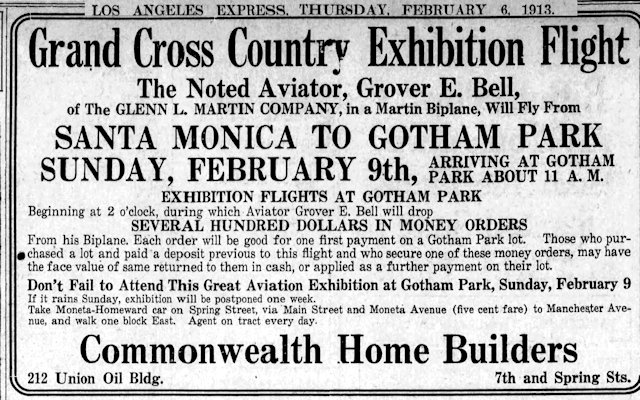 In 1913 Grover Bell flew a biplane in an exhibition to promote a new housing addition (Gotham Park) in Los Angeles.
In 1913 Grover Bell flew a biplane in an exhibition to promote a new housing addition (Gotham Park) in Los Angeles.
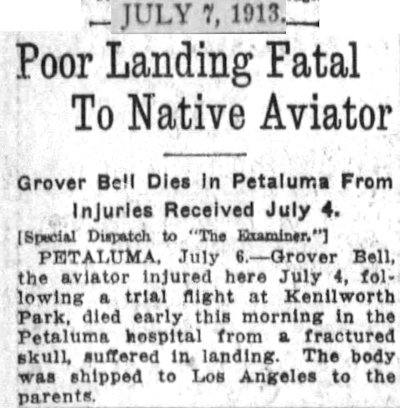 But five months later Grover was killed in an airplane crash. (Lincoln Beachey, too, would die in a plane crash in 1915.) Lawrence, with the death of his brother, considered quitting the aviation business. But his friends talked him out of quitting.
But five months later Grover was killed in an airplane crash. (Lincoln Beachey, too, would die in a plane crash in 1915.) Lawrence, with the death of his brother, considered quitting the aviation business. But his friends talked him out of quitting.
 After America entered World War I Bell listed his occupation as engineer at the Martin company. Bell eventually became Martin’s general manager. The Martin company (which through mergers would evolve into Lockheed Martin) would build military aircraft for both world wars.
After America entered World War I Bell listed his occupation as engineer at the Martin company. Bell eventually became Martin’s general manager. The Martin company (which through mergers would evolve into Lockheed Martin) would build military aircraft for both world wars.
But in 1924 when Bell asked to be made a partner in the company, Glenn Martin refused, and Bell resigned.
In 1928 Bell joined Consolidated Aircraft in Buffalo, New York. Consolidated Aircraft had been founded there in 1923. The company built trainers, observation planes, transports, dive bombers, fighter planes, “flying boats” such as the PBY Catalina, and, of course, the B-24 Liberator during World War II.
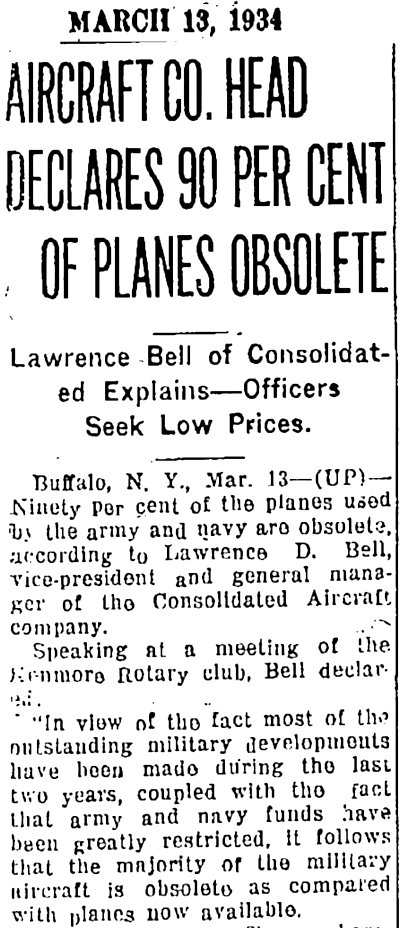 Bell fared better at Consolidated, becoming vice president and general manager.
Bell fared better at Consolidated, becoming vice president and general manager.
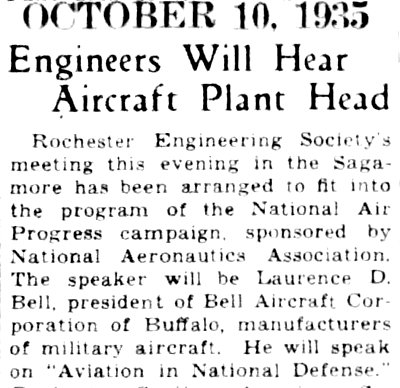 But when Consolidated moved to a new facility in San Diego in 1935, Bell decided to stay behind and form his own aircraft company. In 1935, despite the Great Depression, he founded Bell Aircraft Company. He employed fifty-six people in the building that Consolidated had vacated.
But when Consolidated moved to a new facility in San Diego in 1935, Bell decided to stay behind and form his own aircraft company. In 1935, despite the Great Depression, he founded Bell Aircraft Company. He employed fifty-six people in the building that Consolidated had vacated.
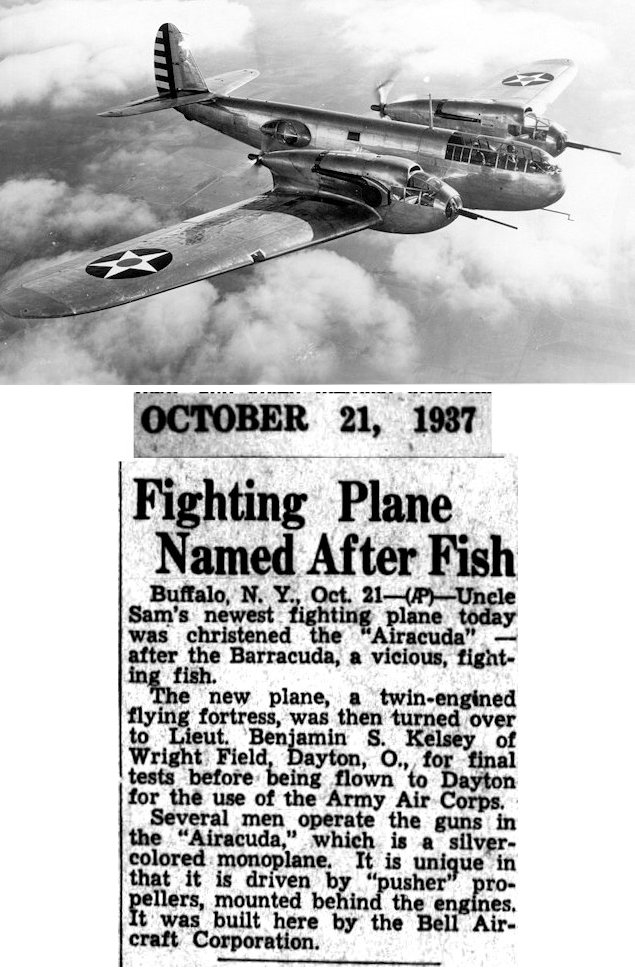 Bell Aircraft’s first military contract was for the Airacuda, named after the fish. The plane’s “pusher” props were mounted on the rear of the wings. Lawrence Bell visualized the heavily armed Airacuda as a “cannon on wings.” But only thirteen Airacudas were built. Not an auspicious beginning for Bell Aircraft. (Photo from Wikipedia.)
Bell Aircraft’s first military contract was for the Airacuda, named after the fish. The plane’s “pusher” props were mounted on the rear of the wings. Lawrence Bell visualized the heavily armed Airacuda as a “cannon on wings.” But only thirteen Airacudas were built. Not an auspicious beginning for Bell Aircraft. (Photo from Wikipedia.)
Film of the Airacuda and Lawrence Bell on YouTube.
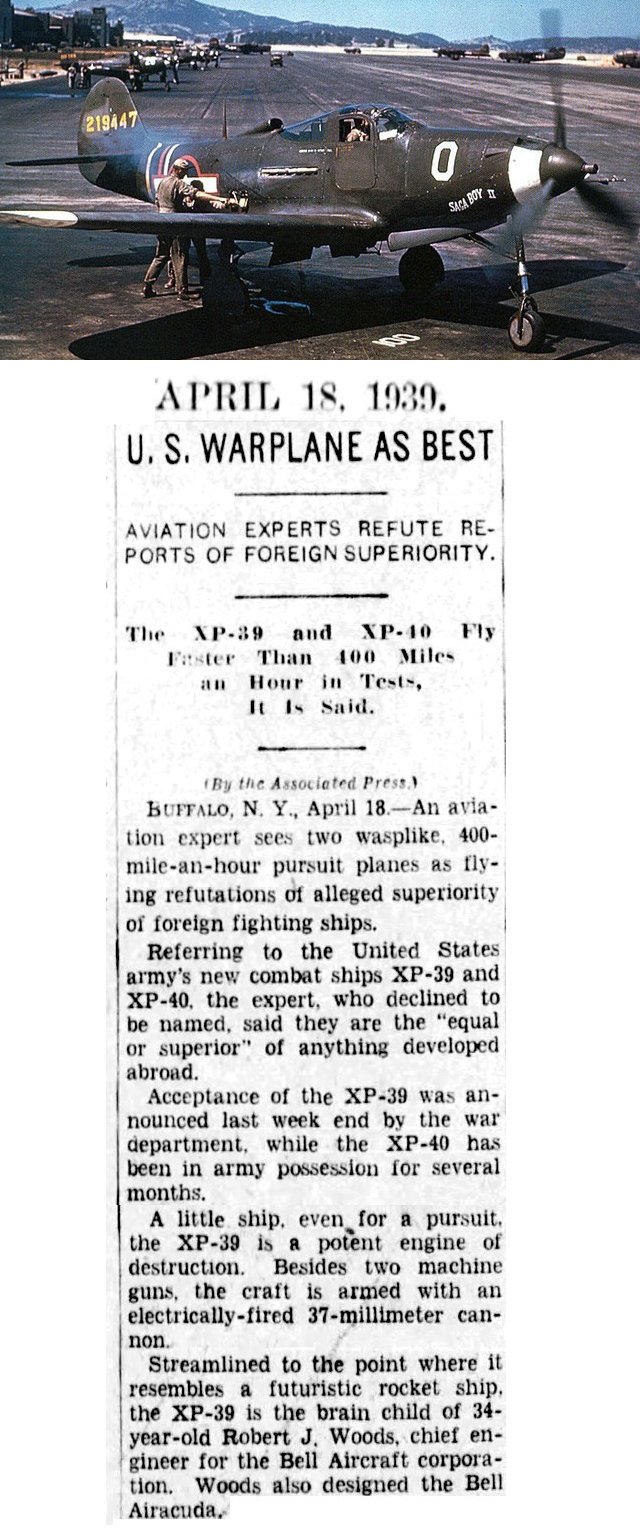 The Airacuda was succeeded in 1938 by the Bell P-39 Airacobra. (In the clip, the XP-40 was the experimental version of the Curtiss fighter flown by General Claire Chennault’s Flying Tigers.) (Photo from Wikipedia.)
The Airacuda was succeeded in 1938 by the Bell P-39 Airacobra. (In the clip, the XP-40 was the experimental version of the Curtiss fighter flown by General Claire Chennault’s Flying Tigers.) (Photo from Wikipedia.)
Unlike the Airacuda, almost ten thousand Bell P-39s were built. Bell Aircraft’s future was cleared for takeoff.
In fact, by 1943 Lawrence Bell would have aircraft plants in Buffalo, Niagara Falls, and Marietta, Georgia. As America fought World War II Bell also helped produce B-29 bombers.
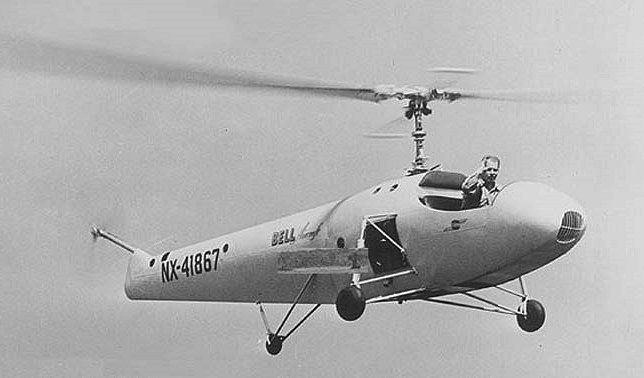 Meanwhile, Lawrence Bell was intrigued by a different form of aircraft. In 1941 he hired Arthur M. Young, who for thirteen years had been experimenting with helicopters.
Meanwhile, Lawrence Bell was intrigued by a different form of aircraft. In 1941 he hired Arthur M. Young, who for thirteen years had been experimenting with helicopters.
Young designed Bell Aircraft’s first helicopter, the Model 30, which first flew in 1943. (Photo from Wikipedia.)
Official Bell Aircraft Corporation film of the Model 30 in 1944 on YouTube.
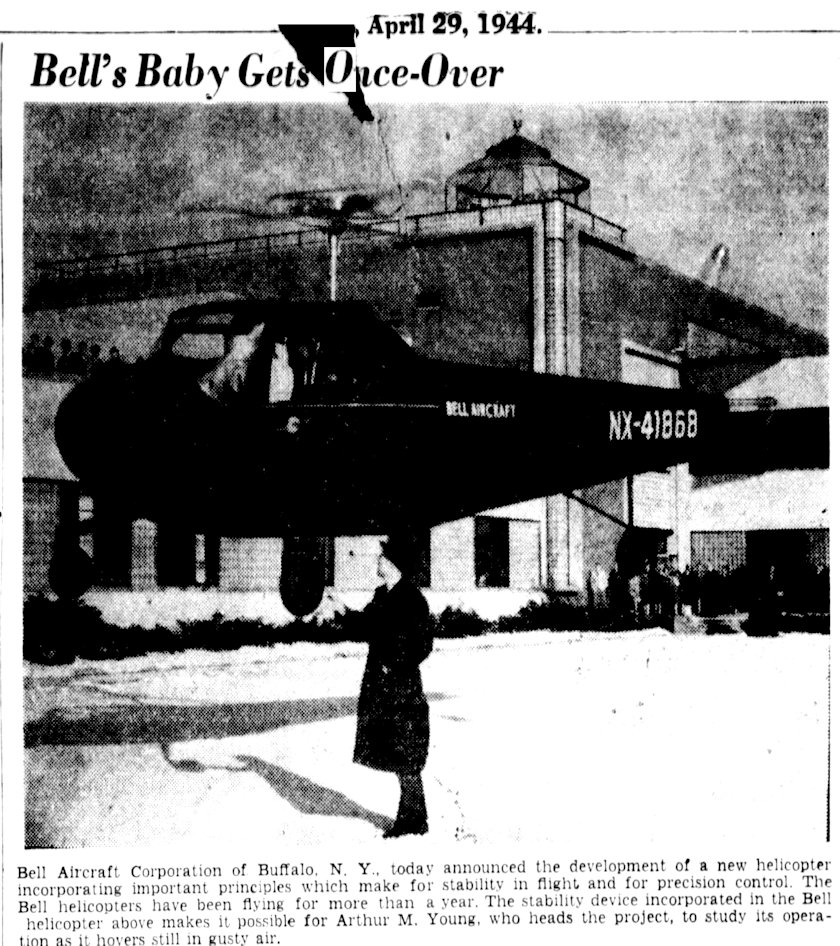 In this photo Arthur Young poses with the second prototype of the Model 30. The Model 30 evolved into the first commercial helicopter, the Bell Model 47, which was certified for civilian use in 1946. More than five thousand Model 47s would be made. The Model 47 would be used by the Army in the Korean War. And in 1958 a Model 47 would become the world’s first telecopter for Los Angeles TV station KTLA.
In this photo Arthur Young poses with the second prototype of the Model 30. The Model 30 evolved into the first commercial helicopter, the Bell Model 47, which was certified for civilian use in 1946. More than five thousand Model 47s would be made. The Model 47 would be used by the Army in the Korean War. And in 1958 a Model 47 would become the world’s first telecopter for Los Angeles TV station KTLA.
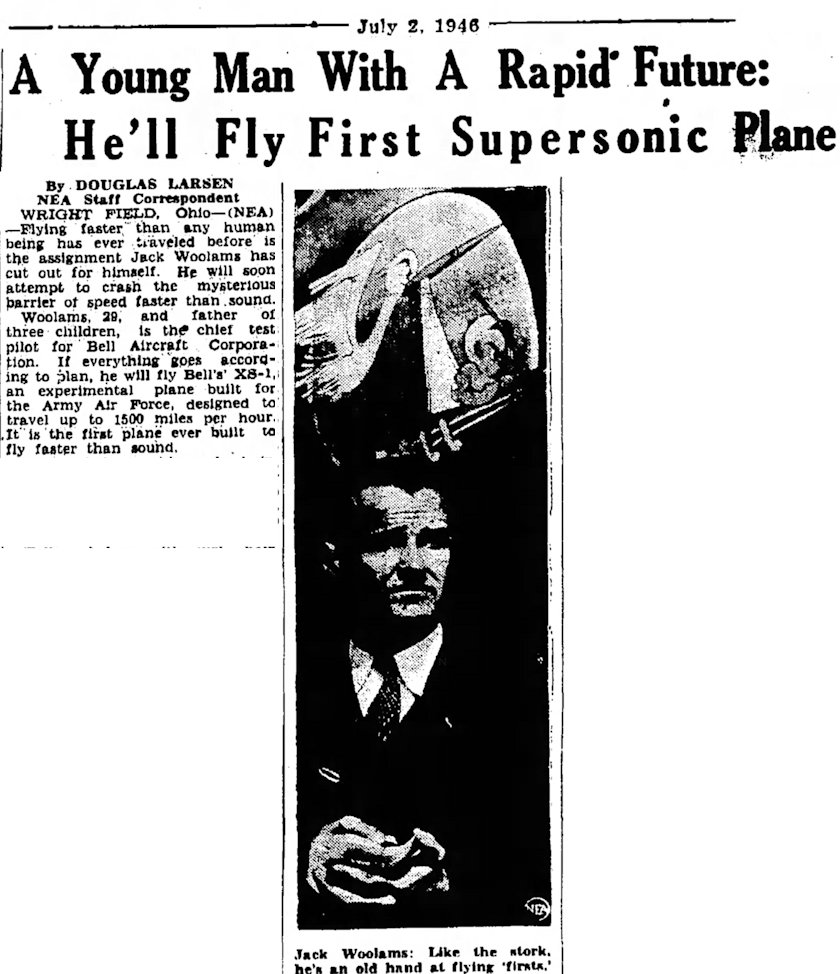 As Lawrence Bell innovated with helicopters, he continued to innovate with airplanes. In 1946, the year the Model 47 helicopter was certified, Bell Aircraft built the X-1, the first airplane designed to fly faster than the speed of sound.
As Lawrence Bell innovated with helicopters, he continued to innovate with airplanes. In 1946, the year the Model 47 helicopter was certified, Bell Aircraft built the X-1, the first airplane designed to fly faster than the speed of sound.
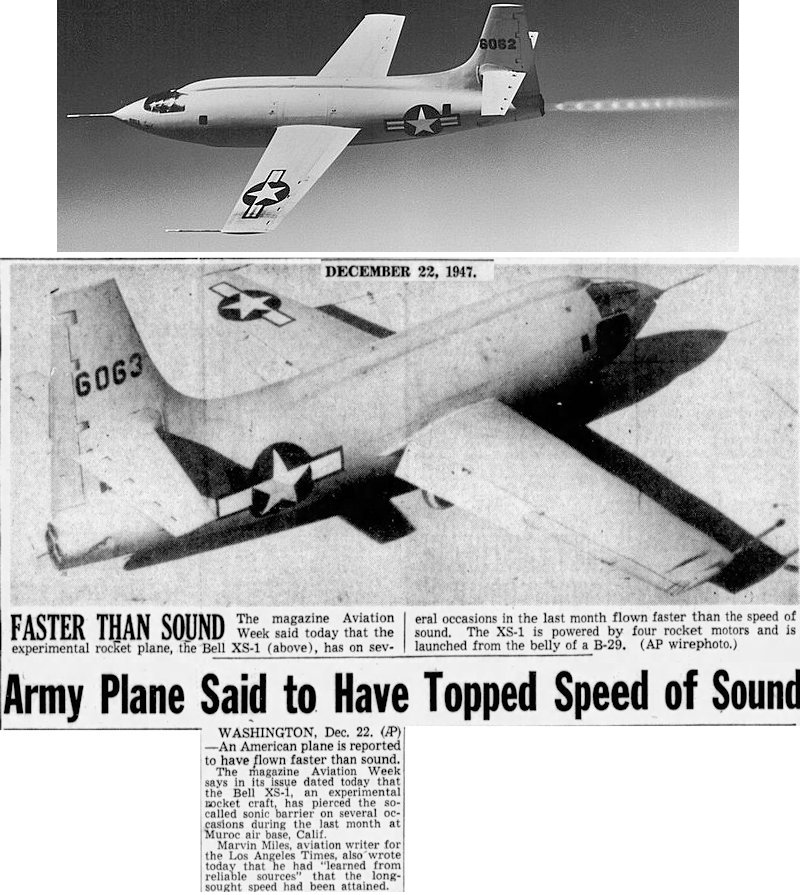 And in October 1947 the Bell X-1, piloted by Chuck Yeager and launched from the belly of a modified B-29, indeed flew faster than the speed of sound. You can see the “shock diamonds” in the exhaust plume created by supersonic flight. (Photo from Wikipedia.)
And in October 1947 the Bell X-1, piloted by Chuck Yeager and launched from the belly of a modified B-29, indeed flew faster than the speed of sound. You can see the “shock diamonds” in the exhaust plume created by supersonic flight. (Photo from Wikipedia.)
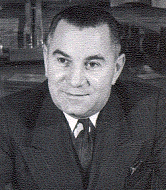
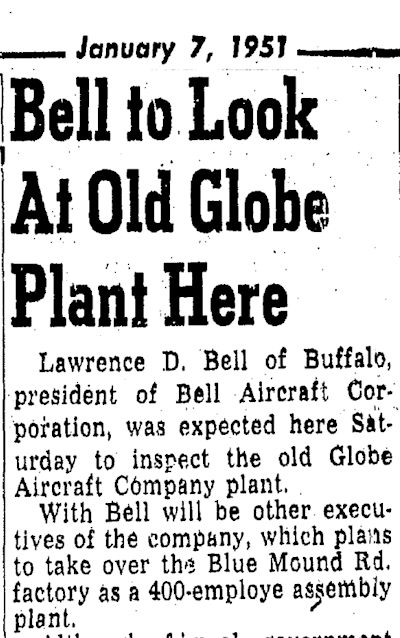 In 1951 Lawrence Bell (pictured) formed a new division of his aircraft company: Bell Helicopter. To house his new division, Bell, prodded by Amon Carter, bought John Clay Kennedy’s (see Part 1) Globe Aircraft plant on Blue Mound Road in Saginaw. Globe Aircraft had closed in 1947. Among the Bell plant’s first contracts was to make engine pods for Convair’s B-36Ds. (Photo from Wikipedia.)
In 1951 Lawrence Bell (pictured) formed a new division of his aircraft company: Bell Helicopter. To house his new division, Bell, prodded by Amon Carter, bought John Clay Kennedy’s (see Part 1) Globe Aircraft plant on Blue Mound Road in Saginaw. Globe Aircraft had closed in 1947. Among the Bell plant’s first contracts was to make engine pods for Convair’s B-36Ds. (Photo from Wikipedia.)
 But the Saginaw plant was just a stepping-stone. Soon Bell began construction of a new plant in Hurst.
But the Saginaw plant was just a stepping-stone. Soon Bell began construction of a new plant in Hurst.
Bell continued to use the old Globe plant in Saginaw into the 1970s.
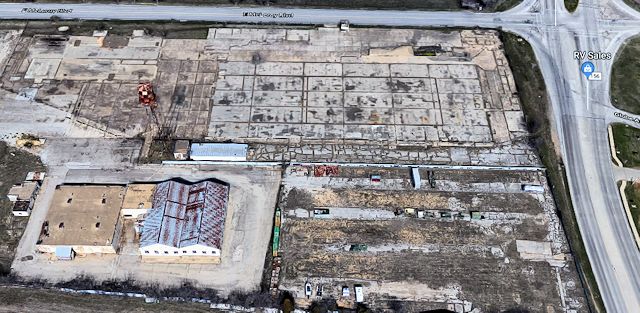
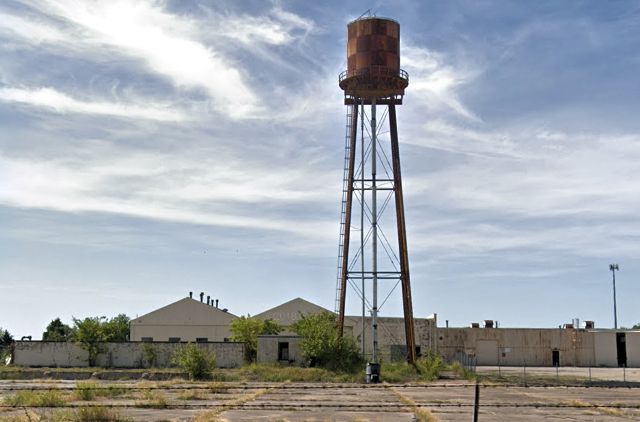 A few buildings of the Globe/Bell plant still stand.
A few buildings of the Globe/Bell plant still stand.
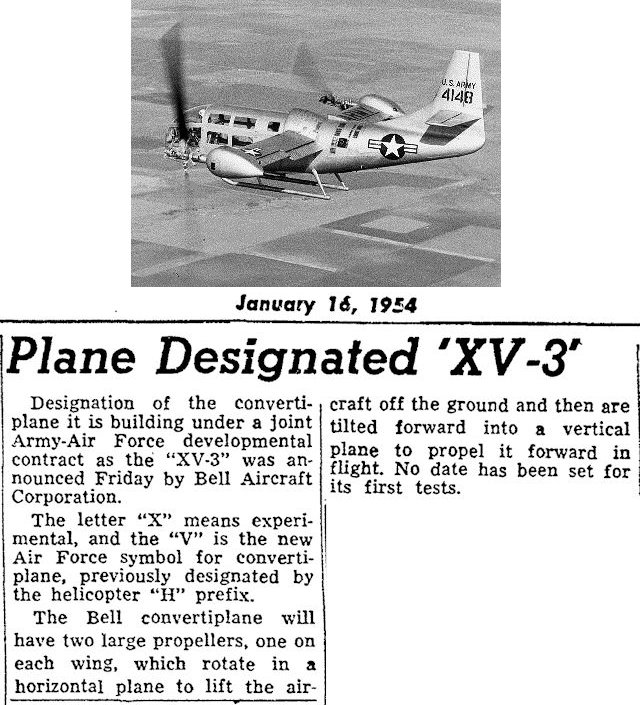 In 1955 Bell Helicopter built the XV-3, its first “convertiplane,” a tilt-rotor aircraft. (Photo from Wikipedia.)
In 1955 Bell Helicopter built the XV-3, its first “convertiplane,” a tilt-rotor aircraft. (Photo from Wikipedia.)
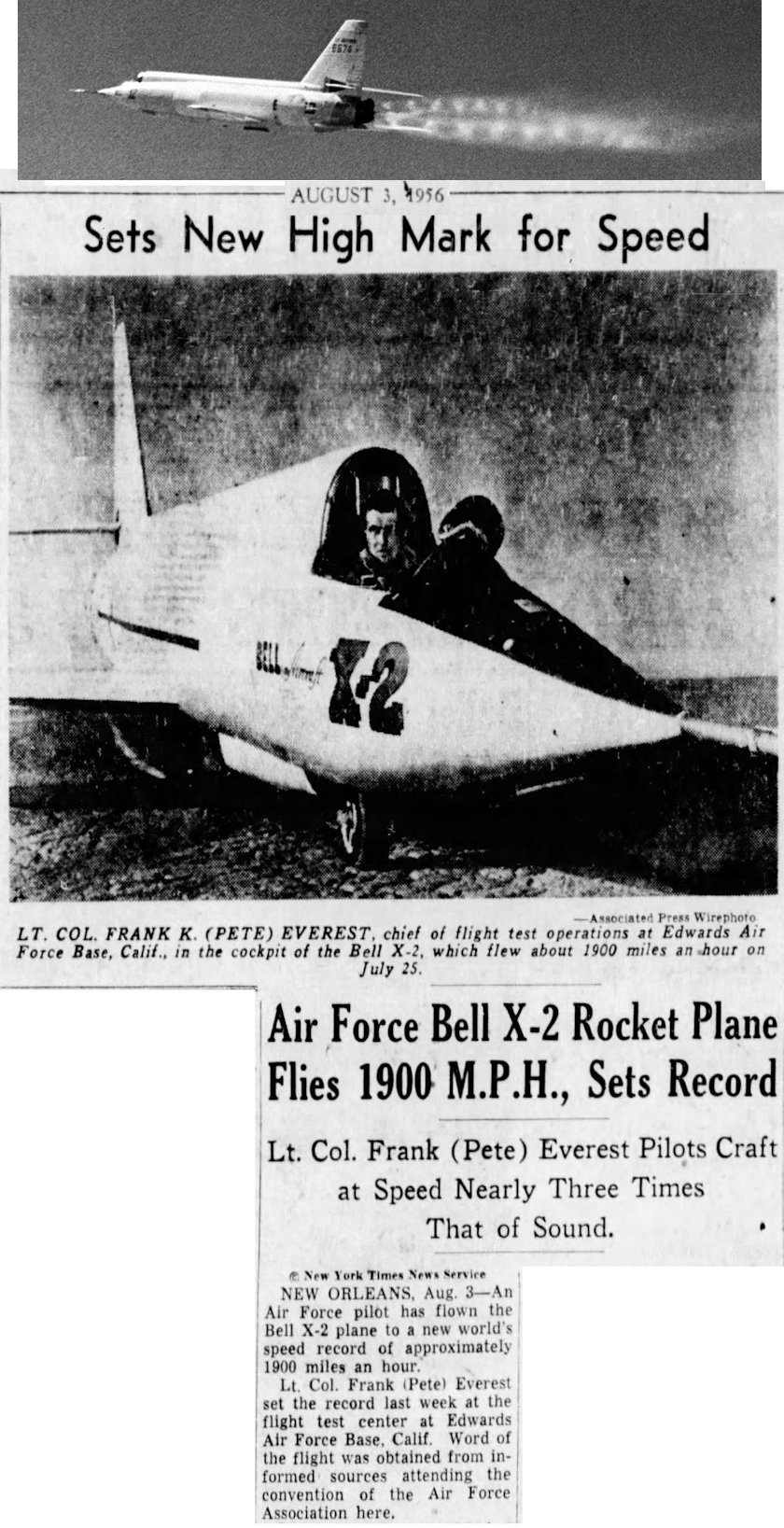 The next year Bell’s X-2 rocket plane set a record with a speed of 1,900 miles an hour. Again, you can see the shock diamonds in the exhaust plume created by supersonic flight. (Photo from Wikipedia.)
The next year Bell’s X-2 rocket plane set a record with a speed of 1,900 miles an hour. Again, you can see the shock diamonds in the exhaust plume created by supersonic flight. (Photo from Wikipedia.)
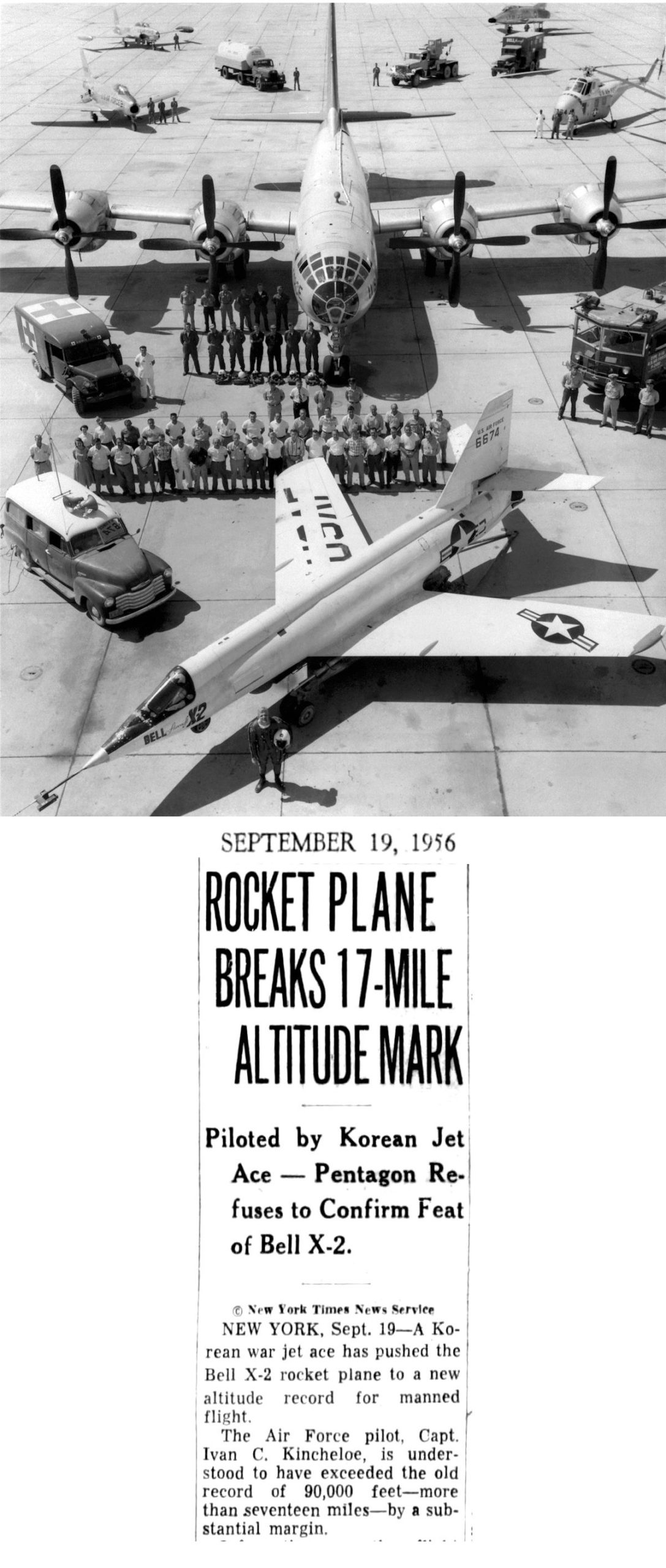 Also in 1956 the Bell X-2 set a record with an altitude of ninety thousand feet. Like the X-1, the X-2 was launched from a modified B-29. (Photo from Wikipedia.)
Also in 1956 the Bell X-2 set a record with an altitude of ninety thousand feet. Like the X-1, the X-2 was launched from a modified B-29. (Photo from Wikipedia.)
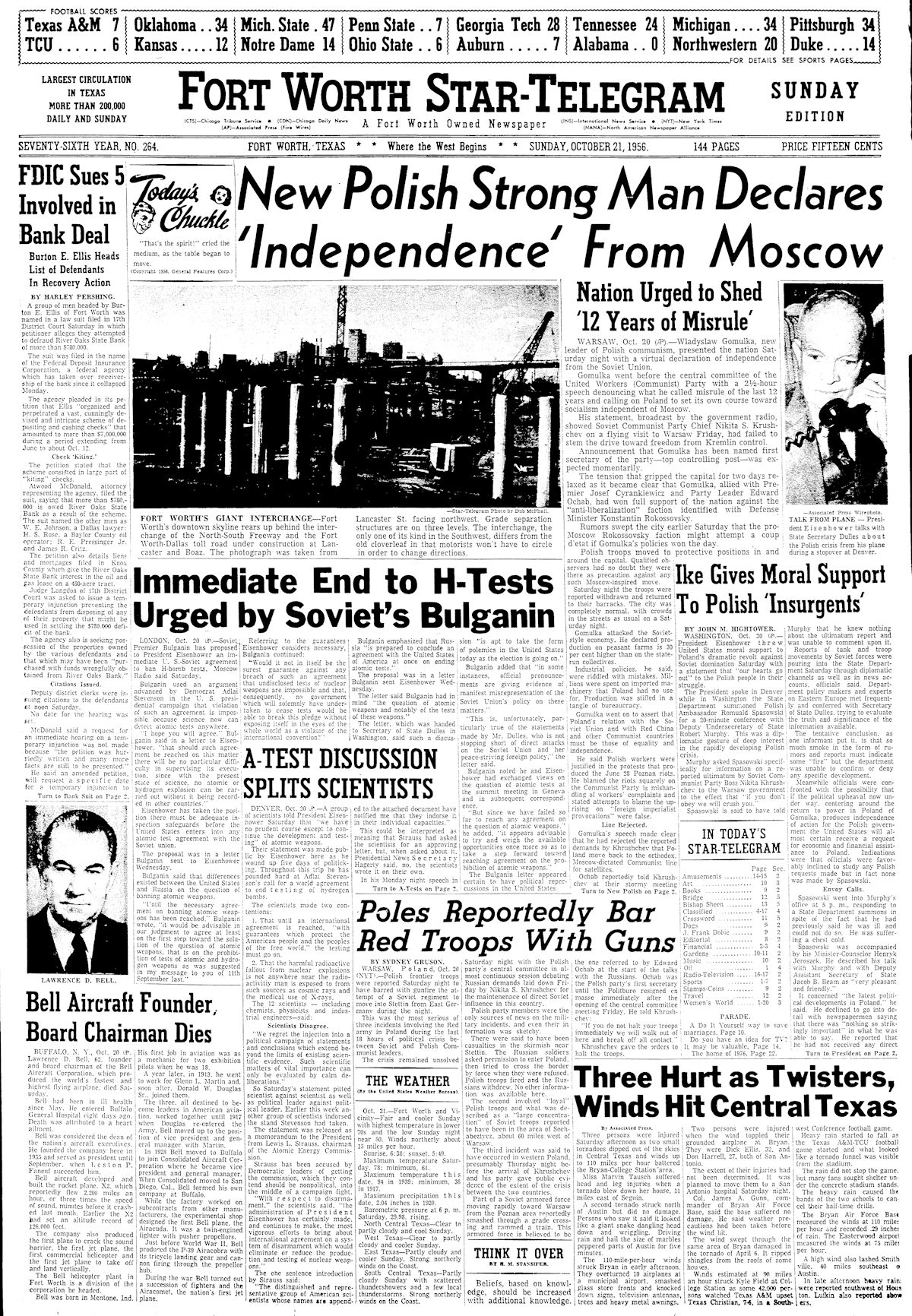 Lawrence Dale Bell died in 1956. Bell, whose life course had been rerouted by an air show when one hundred miles an hour was fast and one mile in the sky was high, had lived to see an airplane with his name on it reach a speed of 1,900 miles an hour and soar seventeen miles above the Earth.
Lawrence Dale Bell died in 1956. Bell, whose life course had been rerouted by an air show when one hundred miles an hour was fast and one mile in the sky was high, had lived to see an airplane with his name on it reach a speed of 1,900 miles an hour and soar seventeen miles above the Earth.
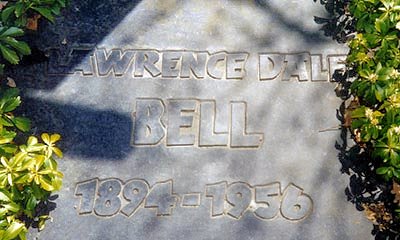 Lawrence Dale Bell is buried in Buffalo.
Lawrence Dale Bell is buried in Buffalo.
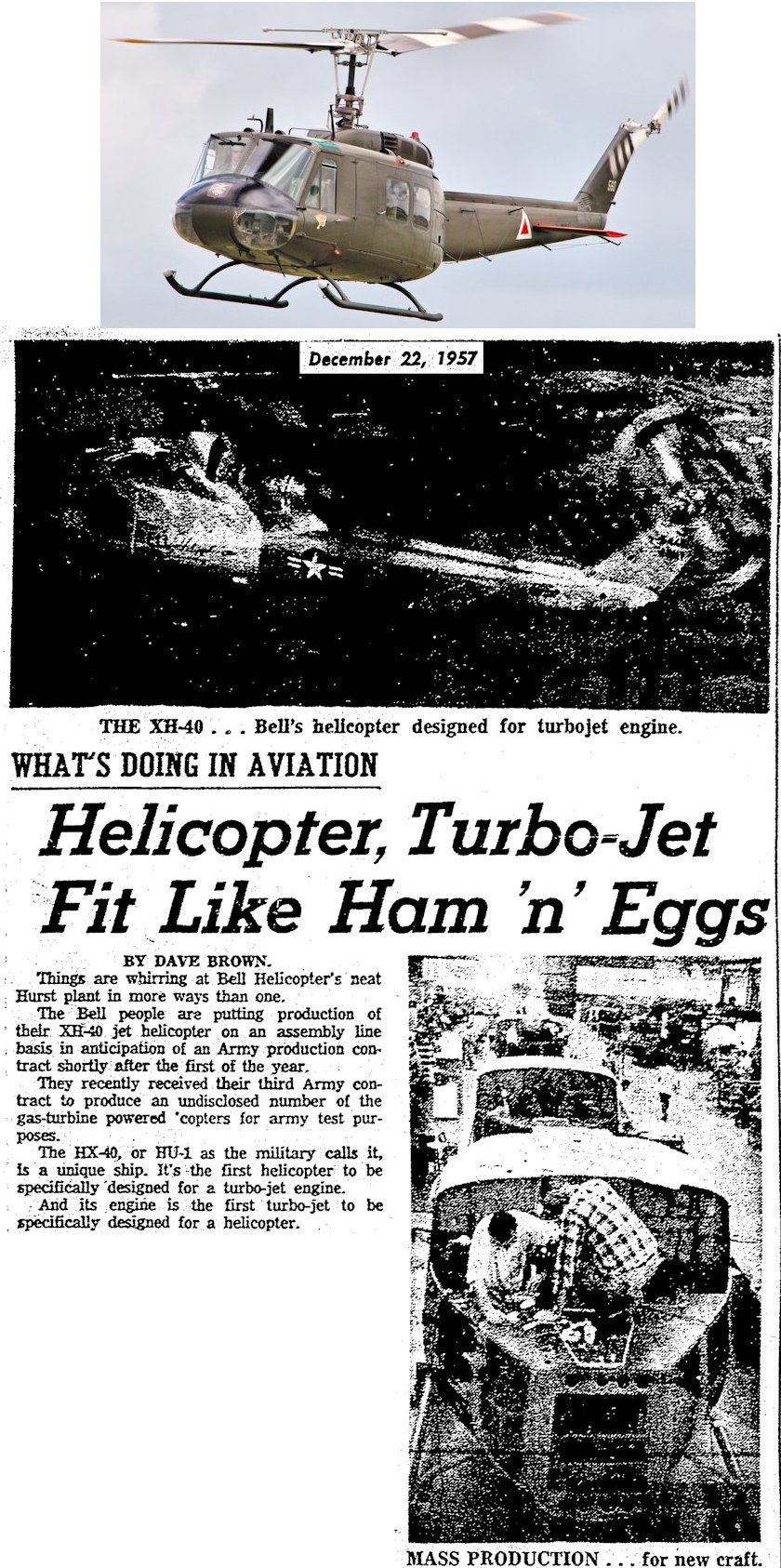 After Bell’s death, the company he founded continued to innovate. The Bell UH-1 Iroquois (“Huey”) was the first turbine-powered helicopter produced for the U.S. military. It first flew in 1956 and was used in combat during the Vietnam War. More than sixteen thousand were built. The Huey evolved into the Bell AH-1 Cobra. (Photo from Wikipedia.)
After Bell’s death, the company he founded continued to innovate. The Bell UH-1 Iroquois (“Huey”) was the first turbine-powered helicopter produced for the U.S. military. It first flew in 1956 and was used in combat during the Vietnam War. More than sixteen thousand were built. The Huey evolved into the Bell AH-1 Cobra. (Photo from Wikipedia.)
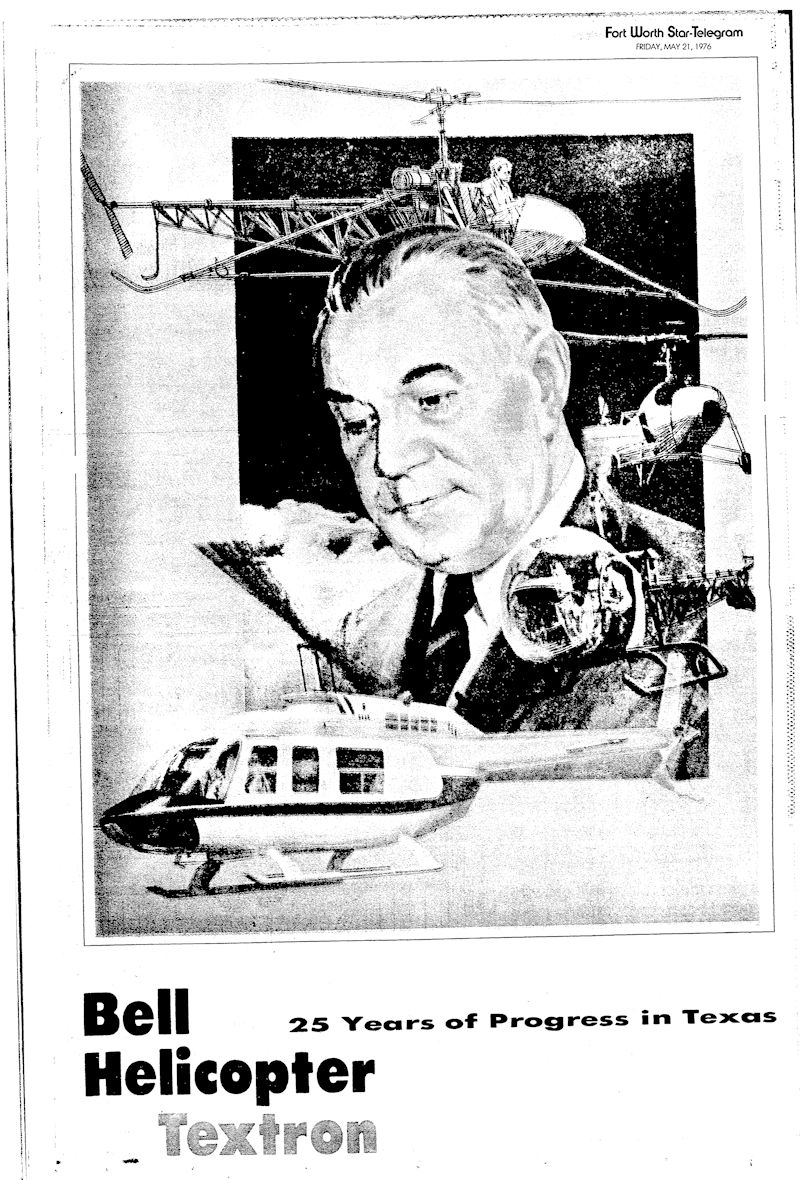 In 1976 Bell Helicopter celebrated twenty-five years in Texas. Bell today is a subsidiary of Textron.
In 1976 Bell Helicopter celebrated twenty-five years in Texas. Bell today is a subsidiary of Textron.
The company expanded its Hurst plant and built facilities elsewhere in Tarrant County and in Texas.
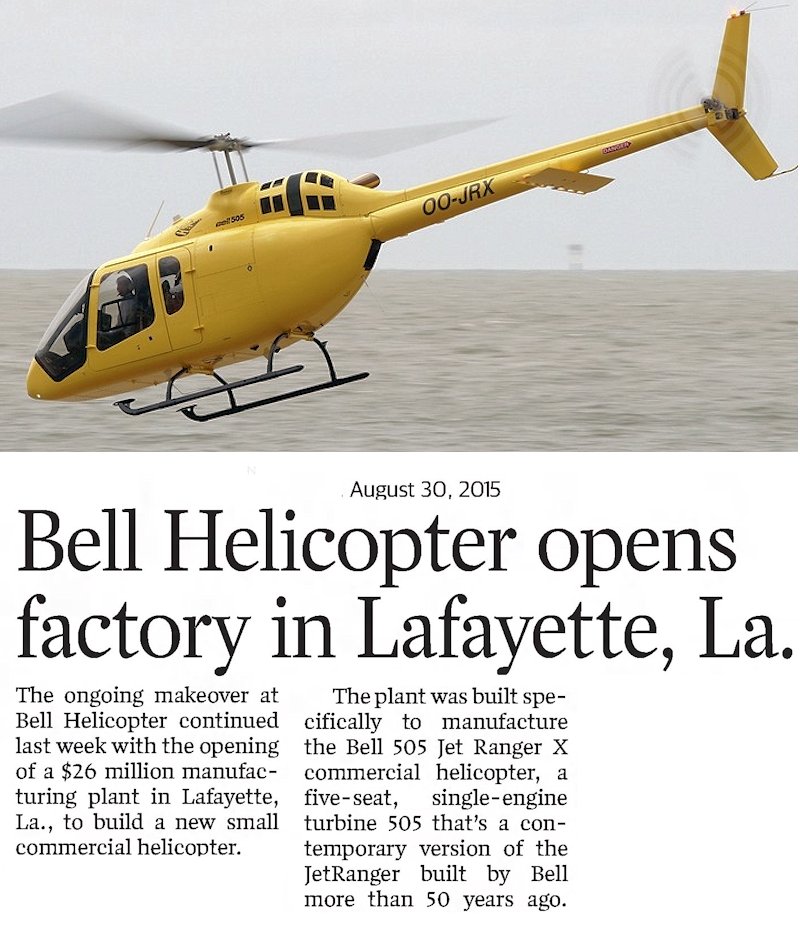 And in Louisiana. The Model 505 is still in production. (Photo from Wikipedia.)
And in Louisiana. The Model 505 is still in production. (Photo from Wikipedia.)
Sixty-nine years after Lawrence Dale Bell brought his helicopter company to the old Globe Aircraft plant in Saginaw, Bell Helicopter remains a leader in the production of military and civilian helicopters and tilt-rotor aircraft. About four thousand people work at the plant in Hurst.
And, yes, L. D. Bell High School in Hurst is named for Lawrence Dale Bell. The school opened in 1957 on Pipeline Road but in 1965 was moved to a site on Brown Trail donated by its namesake.






Larry Bell was recognized twice by King George VI and Queen Elizabeth, The Queen Mother, of the United Kingdom, ( Great Britain ). The history is very long and involved the foundation of today’s aviation. This should be made public, but due to Larry’s unexpected death, it never was made public. the two commendations remained in a bank vault for over 80 years. Please help to bring these events to light. I have spent 10 years researching and have both commendations. I would like to share this information with you. Thank you very much. google — Part 2,3,4,5,6,7,8,9 The Bell P-39 Airacobra Brooches of Lawrence Dale Bell, Founder of The Bell Aircraft Company. —- I will assist and provide all information that I have collected.
Grew up 2.5 miles from the Hurst Bell Helicopter. Helicopter’s were always over head they would touch and go in a field at the end of the street near Circle Dr near Little Bear Creek. You could here them coming and out the door I flew to my bike down to the end of Hurst Dr where it met Circle. Bell had built a special 4 lane strait as an arrow concrete Rd. At night this was the pace for 60’s and 70’s high horse powered cars built buy the son’s of Father’s who worked for Bell, American Airlines and the FAA. Everyone did their own maintenance and the most popular business in Hurst was auto parts stores.